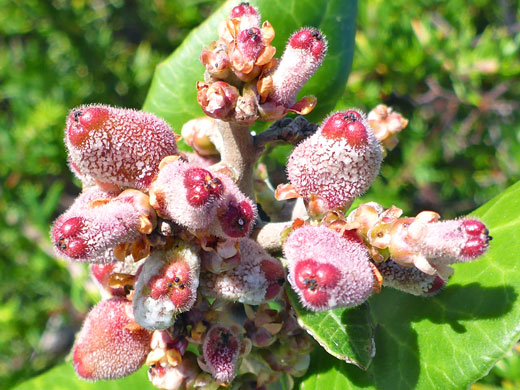Common names:
Lemonade berry, lemonade sumac
Family:
Scientific name:
Rhus integrifolia
Main flower color:
Range:
South and west California
Height:
Up to 25 feet
Habitat:
Chaparral; canyons, hillsides, generally shady locations, up to 2,500 feet
Leaves:
Alternate, shiny, evergreen, simple, up to 2.4 inches long and 1.6 inches wide, on short stalks
Season:
February to May
The evergreen leaves of rhus integrifolia are glabrous, shiny above and dull below, with pinnate venation, the veins branching a few times as they approach the margin, which may be entire, or bear a few small teeth. Plants are large shrubs, up to 25 feet tall, inhabiting sloping terrain in southern California, usually shady, north-facing slopes.
Flowers are produced in clusters at the end of the branches, individual clusters typically containing four or five heads, and attached by thick twigs. Flowers have five ovate, green sepals, covered by short glandular hairs, five pale pink petals, three styles, and five stamens; these with pinkish filaments and large white anthers. Flowers may also be pistillate, for these the stamens are still present but much reduced in size, and infertile. Fruits are reddish drupes, covered with sticky white hairs.
Flowers are produced in clusters at the end of the branches, individual clusters typically containing four or five heads, and attached by thick twigs. Flowers have five ovate, green sepals, covered by short glandular hairs, five pale pink petals, three styles, and five stamens; these with pinkish filaments and large white anthers. Flowers may also be pistillate, for these the stamens are still present but much reduced in size, and infertile. Fruits are reddish drupes, covered with sticky white hairs.
All Contents © Copyright The American Southwest | Comments and Questions | Contribute | Site Map



